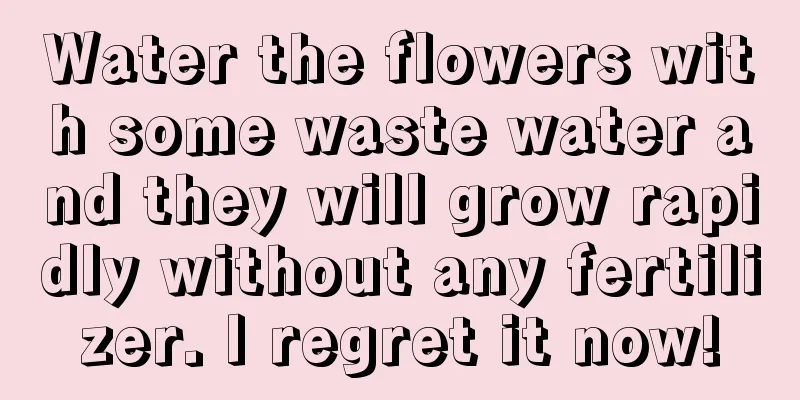Six rules for growing flowers

Abandon carelessnessFlowers, like people, are living things and need careful care. Many flower growers lack the necessary care and diligence in treating these beautiful lives. First, they are lazy and don't like to study the knowledge of flower cultivation. They are willing to be laymen for a long time and do not manage flowers properly. The second reason is that people are lazy and don’t want to spend too much time and energy on flowers. After the flowers are brought into the house, they are often neglected and left aside, suffering from hunger and thirst for a long time, and being tortured by diseases and pests. In this way, even the most beautiful flowers will gradually wither. Therefore, lazy people cannot grow flowers well. 2. Beware of excessive loveIn contrast to the above situation, some flower growers love flowers too much and feel itchy when they are not fiddling with them for a while. Some people water and fertilize without any regularity, watering whenever they remember, causing the flowers to die from overwatering and overfertilization; some people move the flower pots here and there at random, moving them to several places a day, forcing the flowers to frequently adapt to the environment, disrupting their normal growth patterns. If this continues, it would be strange if the flowers are not killed. There is nothing wrong with having a few pots of pleasing flowers at home, but flowers, like people, have their own growth patterns. If you frequently disturb them when they need rest, they will naturally feel tired and will not grow well. Three taboos on fame and fortuneSome flower lovers believe that when growing flowers, one should grow famous flowers, because famous flowers have high ornamental value and can bring huge profits in the market. Under the influence of this mentality, they spared no expense in purchasing famous flowers and trees. The result is often that due to the lack of good maintenance conditions and management techniques, the flowers die soon after they are bought, which not only destroys the precious flowers but also wastes money. This is a conceptual misunderstanding. The correct approach should be to start with ordinary, lower-grade varieties and gradually explore the rules and techniques of flower cultivation. After reaching a certain technical level, you can gradually purchase more expensive varieties, so that you have a greater chance of success. Four Precepts: Distinguishing Good from BadSome flower growers love to grow big and complete flowers, and they will bring home any variety they see, regardless of the variety. This not only makes management difficult, but also brings some flowers that are not suitable for growing into the home, polluting the environment and damaging health. For example, flowers with poisonous juice can easily cause poisoning if people come into contact with them. The smell of some flowers can affect the human nervous system and can easily cause breathing difficulties or even allergic reactions. Plants with sharp thorns on their surface also pose a certain threat to human safety, etc. In short, when growing flowers at home, you should not be greedy and try to find all the best ones, and you should not distinguish between good and bad ones. Instead, you should choose some species that are smaller in size, beautiful in appearance, and harmless to the human body. The Five PreceptsSome flower growers are impatient and have no theme in their flower growing. They change the flowers in their homes like a revolving lantern. This is a big taboo in growing flowers. First, the species are changed too quickly and the planting and breeding time is short, which is not conducive to cultivating flowers and trees with beautiful plant shapes and high ornamental value. Secondly, only trying a few types of flowers will not help improve your flower-growing skills, and you will end up being a flower blind. Therefore, flower growers can only gain success if they choose one or two kinds of flowers and focus on studying and cultivating them. The concept of the Six Precepts is not newNew knowledge and technologies emerge in an endless stream in today's flower-growing industry, but most flower growers still stick to traditional maintenance methods. They are not good at using new technologies and equipment, such as soilless cultivation, odorless flower fertilizers, and various flower containers, in the use of flower containers, water and fertilizer management, and seedling cultivation. As a result, home flower cultivation is unhygienic, unsightly, unnovel, and has significant side effects. |
<<: How to manage and care for potted flowers
>>: Do your flowers need watering?
Recommend
When and how many months can garlic be harvested?
Garlic harvest time Garlic is usually harvested b...
Can dragon bone flowers be grown at home?
1. Can I keep it at home? It can be raised at hom...
Purple cabbage planting time and method
Purple cabbage planting time Purple cabbage is ge...
How to shape bougainvillea bonsai and how to prune it
1. Flower basket style Before making a bonsai sha...
What's wrong with the silkworms not eating or moving?
In rural areas of the south, many places have dev...
The Flower Language and Cultural Symbolism of the Money Tree
Money tree flower language The flower language of...
Goose breeding technology and methods
Raising geese is relatively simple, has a high in...
How often should I water the mimosa? Should I water it every day?
How often should mimosa be watered? How often you...
How to prune juniper bonsai and when is the best time to prune it
Shimpaku bonsai pruning time Shimazu bonsai is us...
Cultivation methods and precautions of moss jade
1. Maintenance methods 1. Substrate selection: Mo...
How to grow aloe vera well
1. Good matrix If you want the plants to grow wel...
How to grow blue fescue
1. Breeding environment 1. Potting soil: As long ...
The efficacy of mosquito grass
1. Efficacy The mosquito grass with galls can be ...
How to grow Jade Dew in winter
1. Stay warm Jade plant is not a very cold-resist...
How to propagate succulent Yuanbao by division, sowing and leaf cutting
How to breed succulent plants There are three mai...









